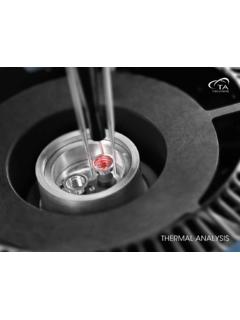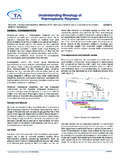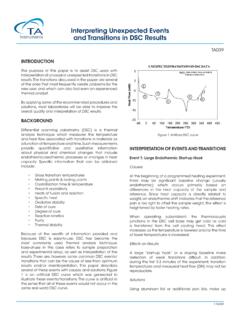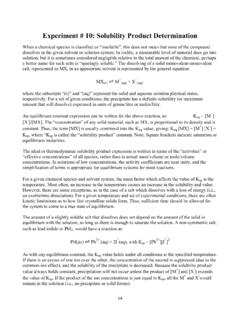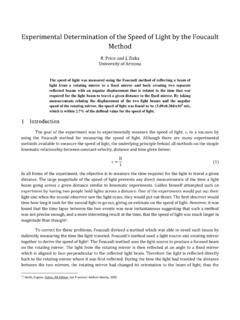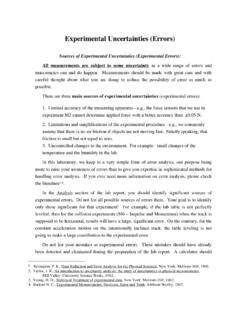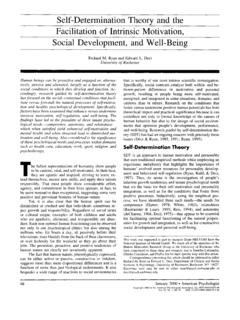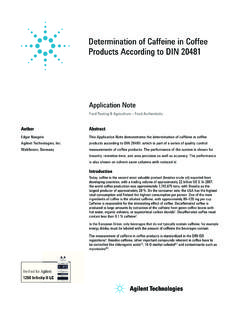Transcription of Determination of Polymer Crystallinity by DSC
1 1 TA123 Determination of Polymer Crystallinity by DSCR oger L. Blaine, Instruments, 109 Lukens Drive, New Castle DE 19720, USAABSTACTP erhaps no fundamental property affects the physical properties of a Polymer inso general a way as the degree of Crystallinity . Differential scanning calorimetry (DSC)provides a rapid method for determining Polymer Crystallinity based on the heat requiredto melt the understanding of the degree of Crystallinity for a Polymer is important ascrystallinity affects physical properties such as storage modulus, permeability, densityand melting temperature. While most of these manifestations of Crystallinity can bedetermined, a direct measure of degree of Crystallinity provides a fundamental propertyfrom which these other physical properties can be is a technique that measures heat flow into or out of a material as a functionof time or temperature.
2 Polymer Crystallinity can be determined with DSC byquantifying the heat associated with melting (fusion) of the Polymer . This heat isreported as Percent Crystallinity by normalizing the observed heat of fusion to that of a100 % crystalline sample of the same Polymer . As authentic samples of 100 % crystallinepolymer are rare, literature values are often used for this value (1,2).EXPERIMENTALIn DSC, the sample contained in a metal pan and the reference (usually an emptypan) sit on raised platforms on the sensors. As heat is transferred through the sensor, thedifferential heat flow to the sample and reference is monitored by area thermocouples. Athermocouple monitors sample temperature. A preheated purge gas is present to provideadditional baseline stability as well as the desired sample/atmosphere this study, samples of polyethylene are analyzed over the temperature rangefrom ambient to 180 C.
3 A heating rate of 10 C/min was used with a nitrogenatmosphere around the sample. Since the previous thermal history of a Polymer affectsthe measured degree of Crystallinity , these samples are evaluated both as received andafter being subjected to a common thermal treatment designed to impart equivalentthermal history to all three samples. This thermal treatment consists of cooling thesample from 180 C at 5 TA123 Figure 1 As Received Polyethylene SampleRESULTSF igure 1 shows the melting endotherm for one of the polyethylene samples duringthe initial as received heating. Universal Analysis software is used to calculate PercentCrystallinity based upon 293 J/g for the 100 % crystalline material (2). The results for thethree samples studied are summarized in Table 1 As Received DSC Characterization of Polyethylene SamplesSampleMelt OnsetTemperature( C)Melt PeakTemperature( C)Enthalpy (J/g) Crystallinity (%) results clearly indicate that samples 1 and 2 are identical in terms ofcrystallinity and melting profile, suggesting that these two polymers were previouslysubjected to the identical processing conditions (thermal history).
4 Sample 3, on the otherhand, has a sharper melt and lower Crystallinity indicating different processing conditionsand different end-use thermal treatment , the three polymers exhibit different crystallinities thaninitially obtained. These results are shown in Table Flow (W/g)020406080100120140160180 Temperature ( C)3 TA123 Table 2 DSC Characterization of Polyethylene Samples after a Common ThermalHistorySampleMelt OnsetTemperature( C)Melt PeakTemperature( C)Enthalpy (J/g) Crystallinity (%) results reflect elimination of earlier processing thermal history effects. It isreasonable to assume that all of these polymers would now have similar final subjecting Polymer samples to different thermal treatments in the DSC prior to thecrystallinity determinations, much may be learned about optimizing may quickly and easily be used to determine the degree of Crystallinity ofthermoplastic polymers through the measurement of the enthalpy of fusion and itsnormalization to the enthalpy of fusion of 100 % crystalline Polymer .
5 Precision istypically a few Wunderlich, Thermal Analysis, Academic Press, 1990, pp. 48, Polymer Heats of Fusion , TA Instruments, New Castle, DEKEYWORDS differential scanning calorimetry, melting, polyolefins, thermoplastic polymers
